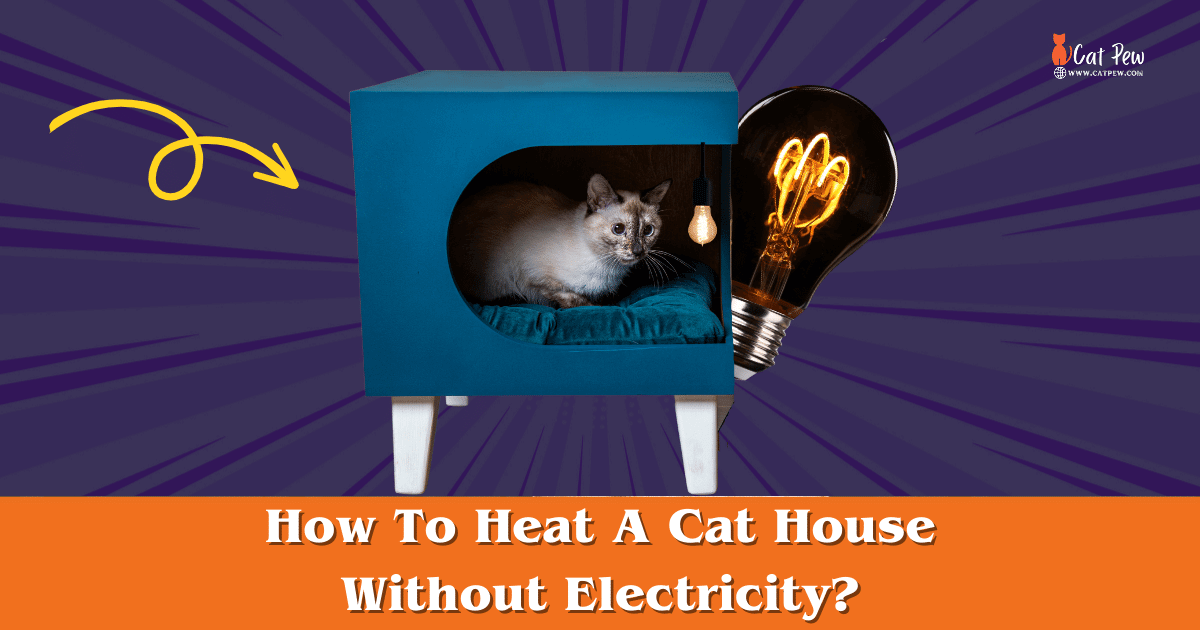How To Heat A Cat House Without Electricity?
To heat a cat house without electricity, you can use alternative heating methods such as insulating the house, providing heated beds or blankets, using a heated pet mat, or installing a solar-powered heating system. These options will ensure your cat stays warm and comfortable during colder months.
By taking these measures, you can create a cozy and safe environment for your furry friend without the need for electricity.
Understanding The Need For Heat In A Cat House
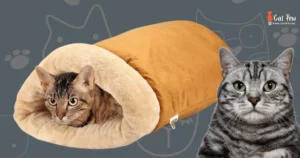
When it comes to providing a warm and comfortable environment for our feline friends, understanding the need for heat in a cat house is crucial. Whether you have an outdoor cat or simply want to give your indoor cats a cozy spot to call their own, ensuring they have sufficient heat is essential for their health and well-being. In this section, we will explore the importance of sufficient heat for a cat’s health and well-being, as well as the risks of cold temperatures for cats.
Importance Of Sufficient Heat For Cat’s Health And Well-being
When we think about cats, we often associate them with warmth and comfort. Cats are naturally drawn to cozy places, with their bodies seeking out warmth to conserve energy and stay comfortable. Providing a cat house with sufficient heat is crucial for several reasons:
- Regulating Body Temperature: Cats, like humans, are sensitive to extreme temperatures. Without proper heating, especially during colder months, cats may struggle to regulate their body temperature efficiently. This can lead to discomfort, hypothermia, and even more severe health issues.
- Promoting Blood Circulation: Adequate heat helps promote proper blood circulation in cats, ensuring that oxygen and nutrients are efficiently transported to their organs and muscles. It also helps to keep their joints supple, reducing the risk of stiffness and arthritis.
- Reducing Stress: Cats thrive in a stress-free environment, and cold temperatures can induce anxiety and discomfort. Adequate heat in their cat house helps create a cozy sanctuary where they can relax, sleep, and feel safe.
- Preventing Cold-related Illnesses: Just like humans, cats are susceptible to cold-related illnesses such as respiratory infections and hypothermia. By providing the right amount of heat, we can minimize the risk of these illnesses and keep our furry companions healthy.
Risks Of Cold Temperatures For Cats
While some cats are more tolerant of chilly temperatures than others, exposing them to prolonged cold conditions can be detrimental to their health. Here are a few risks of subjecting cats to cold temperatures:
- Hypothermia: Cats exposed to low temperatures for extended periods are at risk of developing hypothermia, a condition where their body temperature drops dangerously low. This can lead to lethargy, shallow breathing, and even organ failure in severe cases.
- Frostbite: Cats’ extremities, such as their ears, tails, and paws, are particularly vulnerable to frostbite. Exposing them to freezing temperatures can cause tissue damage, leading to painful sores and potential infections.
- Weakened Immune System: Cold temperatures can weaken a cat’s immune system, making them more susceptible to infections, illnesses, and prolonged recovery times.
- Stress and Anxiety: Constant exposure to cold temperatures can induce stress and anxiety in cats. This can lead to behavioral issues, decreased appetite, and compromised overall well-being.
Understanding the risks associated with cold temperatures emphasizes the need to ensure that your cat house is adequately heated, even without electricity. In the next sections, we’ll explore some effective methods to heat a cat house without relying on electrical power.
Choosing The Right Insulation Materials For A Cat House
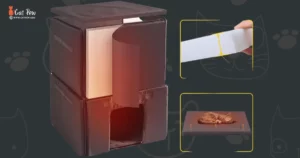
When it comes to providing warmth for your furry friends during cold winter months, choosing the right insulation materials for a cat house is essential. With the absence of electricity, finding alternative ways to keep the cat house cozy becomes a priority. Evaluating different insulation options and considering the relevant factors will help you make an informed decision. Let’s explore how to choose the perfect insulation materials for your cat’s house.
Evaluating Different Insulation Options
When evaluating different insulation options, it is important to consider their durability, effectiveness, and suitability for outdoor usage. Here are a few popular choices:
- Fiberglass insulation: Made from fine glass fibers, fiberglass insulation offers excellent thermal performance and is widely available in stores. However, it can pose health hazards if inhaled, so take necessary precautions when handling it.
- Mineral wool insulation: Manufactured from spun mineral fibers, mineral wool insulation provides good insulation properties and is fire-resistant. It is also resistant to mold and pests, making it a suitable choice for outdoor use.
- Polystyrene foam insulation: This lightweight and affordable material is highly efficient in providing insulation. Available in both rigid and spray foam forms, polystyrene insulation will effectively trap heat within the cat house.
Factors To Consider When Selecting Insulation Materials
When selecting insulation materials for a cat house, several factors should be considered, to ensure optimal warmth and comfort for your feline friends. Here are some important factors to keep in mind:
- R-Value: The R-Value measures the insulation material’s ability to resist heat flow. The higher the R-value, the better the insulation. Aim for insulation materials with higher R-Values to maximize the heat retention in the cat house.
- Water resistance: Outdoor cat houses are exposed to rain and snow, so choosing insulation materials with water-resistant properties will prevent moisture from seeping in and compromising the insulation’s effectiveness. Mineral wool and polystyrene foam are good choices in this regard.
- Ease of installation: Opt for insulation materials that are easy to install and fit securely within the cat house. This will save you time and effort during the installation process while ensuring a snug fit that prevents heat loss.
- Durability: Since the cat house will be exposed to harsh outdoor conditions, durability is crucial. Look for insulation materials that can withstand extreme temperatures, resist decay, and remain effective in insulation for a long time.
By evaluating different insulation options and considering factors such as R-Value, water resistance, ease of installation, and durability, you can choose the right insulation materials to provide adequate warmth for your cat house without the need for electricity. Keep your feline friends cozy and comfortable even during the coldest of winter days!
Implementing Passive Heating Techniques
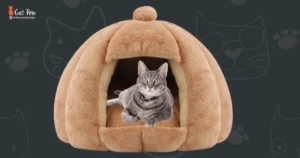
Utilizing Solar Energy For Heating Purposes
One effective and eco-friendly way to heat a cat house without electricity is by harnessing the power of the sun. Solar energy can be utilized to provide warmth and comfort to your furry friends. Position the cat house in an area that receives ample sunlight throughout the day. This will allow the house to absorb and retain heat, keeping it warm even during colder periods.
Insulated Bedding For Added Warmth
Another key aspect of passive heating is ensuring proper insulation within the cat house. By choosing insulated bedding materials, you can create an additional layer of warmth for your pets. Insulated bedding materials like straw or blankets help to retain heat, keeping the cat house cozy. Place this bedding in a way that covers the floor and walls, creating an insulated environment that traps the heat inside.
Creating An Optimal Position And Layout For The Cat House To Maximize Heat Retention
To maximize heat retention in the cat house, it is crucial to establish an optimal position and layout. Here are some tips:
- Place the house away from any drafts or strong winds to avoid cold air seeping in.
- Position the entrance away from the prevailing wind direction to prevent cold drafts from entering the house.
- Ensure the cat house is raised off the ground to prevent heat loss through direct contact with a cold surface.
- Consider orienting the house so that it faces the sunny side, maximizing exposure to the sun’s warmth.
By implementing these passive heating techniques, you can provide a cozy and warm cat house for your feline companions, even without electricity. Take advantage of solar energy, choose insulated bedding, and carefully position and layout the cat house to maximize heat retention. Your cats will appreciate the extra warmth, especially during colder months.
Alternative Heating Options For Cat Houses
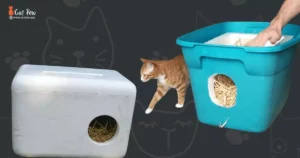
When it comes to providing warmth for your feline friends during chilly days and nights, several alternative heating options for cat houses can keep them cozy without the need for electricity. These options are not only portable and safe but also designed to meet the specific needs of outdoor cats. Let’s explore some of the options below:
Portable heating devices provide an efficient way to heat cat houses without electricity. These devices are designed with safety in mind, ensuring that your furry companions stay warm without any potential hazards. They are lightweight and easy to move around, allowing you to adjust the heating position based on your cat’s preference.
Heating pads specifically designed for outdoor use are another excellent option for keeping your cat’s house warm without electricity. These pads are waterproof and equipped with a chew-resistant cord, ensuring durability and safety. The heating pads provide a gentle and consistent warmth, creating a cozy spot for your cat to curl up and relax.
Utilizing Microwavable Heating Discs for Short-Term Heating Needs
Microwavable heating discs offer an ideal solution for short-term heating needs in your cat house. These discs can be heated in the microwave and then placed inside the cat house to provide warmth for several hours. They are perfect for those chilly evenings when your cat needs a little extra heat and can be easily reheated as needed. Remember to follow the instructions provided by the manufacturer for safe usage.
| Heating Option | Benefits | Considerations |
|---|---|---|
| Portable and Safe Heating Devices | Easy to adjust and move around, lightweight, safe for outdoor use | May require batteries or fuel, a limited heating area |
| Heating Pads Designed for Outdoor Use | Waterproof, chew-resistant cord, gentle and consistent warmth | Requires constant power source, may get too hot if not regulated |
| Microwavable Heating Discs | Convenient, easy to use, reusable, provides short-term warmth | Requires access to a microwave, limited heating duration |
In conclusion, there are various alternative heating options available for cat houses that can ensure your furry friends stay warm and comfortable without relying on electricity. Whether you choose portable heating devices, outdoor heating pads, or microwavable heating discs, you can provide a cozy sanctuary for your beloved cats even during the coldest days.
Daily Maintenance Tips For Cold Weather Cat Houses

Providing a warm and comfortable environment for your feline friends during cold winter days is crucial. Proper daily maintenance of the cat house will ensure that your furry companions stay cozy and safe. In this article, we will explore some essential tips on how to keep your cat’s house warm without electricity. Let’s dive in!
Regularly Monitoring The Temperature Inside The Cat House
It is important to regularly check the temperature inside the cat house to ensure it stays within a comfortable range. Use a thermometer to monitor the temperature. The ideal temperature for most cats is between 75-80 degrees Fahrenheit. This will help prevent your kitty from feeling too cold or overheated.
Inspecting The Insulation For Any Damage Or Wear
Inspecting the insulation of the cat house is crucial to maintain its warmth. Regularly check for any signs of damage or wear and repair them promptly. Insulation acts as a barrier against the cold and helps retain heat. Replace any torn or damaged insulation material, such as foam or straw. This will provide an additional layer of protection against the chilly weather.
Providing Extra Warmth Through Cozy Blankets And Heated Cat Beds
Ensuring your cat has enough warmth is essential during cold weather. Consider adding cozy blankets or heated cat beds inside the cat house. These will provide extra insulation and help keep your furry friend warm and comfortable. Ensure that the blankets and beds are clean and dry to prevent any discomfort or health issues. Replace the bedding regularly to maintain hygiene and freshness.
Using heated cat beds is a great option for keeping your cat warm without electricity. These beds are designed to provide a controlled amount of heat, ensuring your cat stays snug. Position the heated bed away from any water sources to avoid accidents and provide a safe and cozy spot for your cat to relax.
Summary
By regularly monitoring the temperature, inspecting insulation for damage, and providing extra warmth through cozy blankets and heated cat beds, you can ensure that your cat house remains a comfortable retreat for your furry companions during the cold winter months. Taking these daily maintenance tips into account will help create a warm and safe environment for your beloved cats. Keep them cozy and happy throughout the chilly season!
Frequently Asked Questions On How To Heat A Cat House Without Electricity
How Can I Keep My Cat House Warm Without Using Electricity?
There are several ways to heat a cat house without electricity. You can use insulation materials like straw or Styrofoam, provide heated beds or pads, use a solar-powered heating system, or even use a hot water bottle or microwavable heating pad to keep your cat warm.
What Is The Best Material To Insulate A Cat House For Warmth?
The best materials to insulate a cat house for warmth are straw and Styrofoam. Straw is inexpensive and can provide excellent insulation properties. Styrofoam, on the other hand, is a lightweight and durable material that can be easily cut to fit the cat house’s walls and roof, providing effective insulation.
How Can I Keep My Cat Warm Without Electricity?
You can use a heated cat bed or blanket specifically designed for pets.
Can I Use A Heated Bed Or Pad For My Cat’s House?
Yes, you can use a heated bed or pad to keep your cat’s house warm. There are various options available, including electric and self-warming beds or pads. Electric beds or pads require an electrical outlet while self-warming ones use your cat’s body heat to provide warmth without electricity.
What Are Some Alternative Heating Methods For A Cat House Without Electricity?
Some alternatives include using microwavable heating pads, thermal blankets, or insulated bedding materials.
Is It Safe To Use A Heat Lamp In A Cat House?
It’s not recommended as heat lamps can pose fire hazards and may be too intense for the cat’s comfort.
How Do Solar-powered Heating Systems Work For Cat Houses?
Solar-powered heating systems for cat houses use the sun’s energy to generate heat. These systems typically consist of solar panels, a battery, and a heating element. The solar panels collect sunlight and convert it into electricity, which is stored in the battery. The heating element then uses this stored energy to provide warmth inside the cat house.
Can I Build My Own Diy Heating Solution For A Cat House?
Yes, you can create your own DIY solution using hand warmers, hot water bottles, or other safe heating elements.
How Can I Make My Cat’s House Warm In The Winter?
You can use a heated cat bed or place a cozy blanket near a sunny window to keep your cat warm.
How Can I Create A Cozy Environment For My Cat During Cold Weather Without Electricity?
Ensure your cat has access to warm, sheltered areas, and consider using insulated boxes or dens.
Conclusion Of How To Heat A Cat House Without Electricity
Keeping your furry friend warm during the winter can be a challenge, especially without electricity. However, with a little creativity and resourcefulness, you can provide a cozy haven for your cat. From using insulated bedding and heated blankets to constructing a DIY heated cat house, there are various ways to ensure your feline companion’s comfort without relying on electricity.
By implementing these alternative heating methods, you can keep your cat warm and happy throughout the colder months. Give it a try and see the difference it makes for your beloved pet.

Jonathon
I love cats, I have more than 10 years of experience in raising cats. I want to share with everyone useful knowledge about cats.

